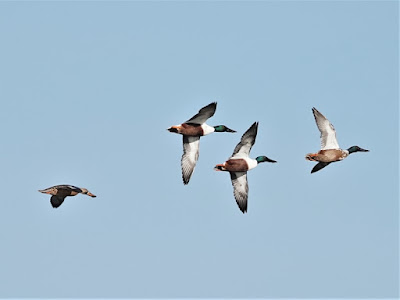I started with a quick visit to the RSPB Reserve at Burton to check what was around. In front of the visitor centre was a pair of Pintail, the smart drake here behind a drake Eurasian Wigeon. A duck Eurasian Wigeon is on the right. The duck Pintail is head-on and can be identified by its all black bill. Black-headed Gulls spoil the view.
A Great White Egret was a welcome sight in a pool alongside the visitor's centre.
Then it was off to Parkgate and the spectacle. Passing by are some of the thousands of Pink-footed Geese in the area. In the distance some ducks join the throng. The other side of the River Dee is Bagillt in Wales.
Here is a Pink-footed Goose, calling.
A small group of four.
And two dropping it join some already on a still-dry part of the marsh.
I was surprised to see a group of Stock Doves using the marsh.
Two Black-tailed Godwits pass by. These can be distinguished from the somewhat similar Bar-tailed Godwit by their long straight bill (very slightly recurved in the Bar-tailed); their feet sticking out well beyond the tail (the legs of the Bar-tailed are shorter); and their very prominent wing-bar (that the Bar-tailed lacks).
Behind the Black-tailed Godwits are smaller Redshanks.
The rising tide is now forcing the Redshanks to move on.
There are many Little Egrets like this in the marsh. They always outnumber Great White Egrets.
A Little Egret flies by as two Pink-footed Geese come in to join a Canada Goose.
As the tide comes in the egrets gather on the remaining dry areas.
A Little Egret and a Black-headed Gull crash the photo of Black-tailed Godwits and Redshanks.
A bird I did not see until I looked at the photo was the Common Snipe in the left foreground. There were plenty of snipe around but getting a photo of them was a challenge that I failed. Also visible here is a (blurred) Starling disappearing top right.
Three Curlews fly over.
Marsh Harriers patrol the marshes looking for small mammals and birds. The cream cap indicates this is a female.
Here is another female: they always seem to outnumber males.
This was by far the 'bird of the day'. Typically falcon-shaped it is a Merlin, a species I have not seen for at least ten years. A formidable predator it typically relentlessly chases its small bird prey and captures them in flight.
A few minutes later it flew back. I pointed my new camera at it. This distant image was one of a sequence it captured.
With much cropping, boosting both the exposure and contrast I managed to extract this amount. A remarkable achievement by the camera.
Another view is definitely needed of this very special sighting.
A male Kestrel joined the fun. The underside.
And the upper side.
With the tide now very high most birds other than gulls had flown away. This Black-headed Gull was patrolling the area.
A first year Herring Gull.
A trio of Lesser Black-backed Gulls. Between two adults is a first year.
A different first year Lesser Black-backed Gull.
What it was looking for as the tide flooded the last of the marsh were Water Voles forced out of cover to swim. The gull was grabbing them.
Here is another adult Lesser Black-backed Gull with its prize. This one still has some winter head markings remaining.
Observation showed that the Lesser Black-backed Gull were unusual. The smaller Black-headed Gulls were more agile and better able to pick up the voles. Much of the time the Lesser Black-backs were harrying the Black-heads to drop the voles. Here a first year Black-headed Gull has the prize with another first year to the left and two adults to the right.
Three of them again.
Lots of squabbling.
Plane of the day. The birds were none too happy about a low pass by this Eurocopter built AS 355N Twin Squirrel operated by Cheshire Helicopters from the Knutsford area.
As the tide began to drop I headed off to Hoylake to look for waders dispersing from the high-tide roost.





































































